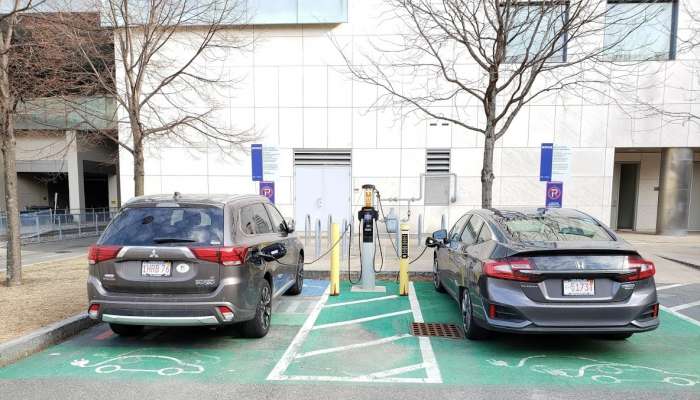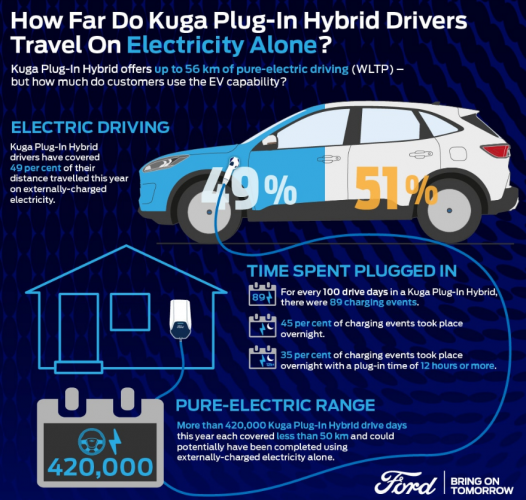As the global automotive fleet transitions away from liquid fuels, various types of green vehicles have emerged since the days when the Prius Hybrid was the only game in town. One type is the plug-in hybrid-electric vehicle (PHEV). These vehicles offer travel flexibility, consumer familiarity, and a low consumer cost. However, those who wish to see America end its addiction to liquid fuels cold turkey wring their hands over the idea that such a technology could end up a “methadone treatment” of sorts, and delay the progress of battery-electric vehicle (BEV) adoption. Critics of PHEVs say their main worry is that the owners of plug-in hybrid-electric vehicles will not plug them in. There are many reasons why this is really not a concern. One is data. Others relate to the advantages of EV operation.

What Are Plug-in Hybrids?
Plug-in hybrid-electric vehicles are hybrids that can operate for many miles on EV power alone, and then go back to being super-efficient hybrids when their traction battery range is used up. For example, the Toyota RAV4 Prime is rated at 42 miles of EV range before it begins operating as a 38 MPG all-wheel drive crossover. Honda’s Clarity PHEV sedan was a lot like an Accord, but with the ability to travel 48 miles in EV mode. Lexus, Ford, Kia, Hyundai, Mazda, Mitsubishi, and a few other brands all have new for ‘22 PHEVs coming to market. So what’s the downside of being able to commute using zero gas during a typical commute?
Related Story: 5 Plug-in Hybrid EV Myths Battery-Electric Purists Wish Were True
Imaginary Concerns About PHEVs
Some battery-electric advocates believe that PHEV owners buy their vehicle, experience the joy of EV-only operation, and then fail to plug them in. This is illogical. As anyone who has ever driven a PHEV knows, they drive “better” when the battery is charged. They are quieter, smoother, and drive exactly like battery-electric vehicles in EV Mode. Their peak performance is in hybrid mode using both EV and hybrid power. So who would want to pass up that satisfying driving feeling and peak performance opportunity? Pretty much nobody who owns one is the answer.
Are PHEVs Inexpensive to Own and Operate?
Operating a PHEV using electricity is also more cost-effective. Even when gas was cheap this was true. Operating a PHEV in EV-only mode rather than hybrid mode with a depleted battery saves money. PHEV owners know this and of course, want to enjoy the lower cost of ownership. Many, if not most, green vehicle owners are also environmentally responsible people. They prefer not to use gasoline when they need not.
Would EV Owners Rather Charge or Pump Gas?
EV advocates of all types often post on social media that they just love plugging in their cars at home, usually inside of a garage, to power them rather than stop for smelly gas and stand outside in the cold or rain pumping in the fuel. “It takes literally 10 seconds to charge an EV” is a common post. It’s true in the sense that one simply grabs the charger handle and sticks it into the car. When one comes back to the car, one pulls it out and presses it into the wall-mounted holder. Why would a PHEV owner ignore this much more convenient way to provide energy to a car? We have no idea, but feel free to tell us in the comments below.
The Chevy Volt Data
The most popular PHEV in America thus far, and for about a decade the top-selling EV of any type, was GM’s popular Volt. The Volt was technically an EREV, which stands for extended-range electric vehicle. In practice, the Volt worked the same way a PHEV like the Clarity does. To determine how often owners operated the Volts they owned in EV mode using electricity as opposed to relying on the gasoline range extender, the U.S. Department of Energy conducted owner research. The findings indicated that Volt owners overwhelmingly used EV mode. Because the owners could also take long trips in their cars and never needed to charge during the journey, Volt owners covered more EV miles than Nissan Leaf owners (the Leaf is a battery-only vehicle). The Volt was a real-world practical way for owners to drive most of their miles on electricity day in and day out, but operate their cars as super-efficient hybrids when they wished to head out on a rare road trip. The Volt has been retired by GM, and was replaced with the Bolt and Bolt EUV, now both off the market due to battery fires. As this story is written, GM doesn’t sell an affordable green vehicle of any type. It does sell a wide selection of V8-powered full-size trucks, SUVs, and sports cars. How did GM retiring the Volt to shift to BEVs help the environment?
Related Story: What Is and Is Not an Electric Car?
The Ford Kuga PHEV (Escape) Data
Europe is about five years ahead of the U.S. with government mandates related to emissions. After a ridiculously ignorant brainwashing campaign that somehow portrayed dirty diesels as a better alternative to cleaner and faster gas-powered hybrid cars, the Continent’s reaction is to now fix what was broken and just force automakers to sell cleaner cars. Included in this plan are PHEVs.

Europe’s best-selling PHEV today is the Ford Kuga, a compact five-passenger crossover very similar in size to America’s Ford Escape or Toyota RAV4. Ford conducted an owner study to determine how many miles driven by Kuga PHEV owners are from electricity (from an external source) and how many miles were traveled in hybrid mode. The resulting data showed that almost exactly half of all Kuga PHEV miles were electric. The simple to understand conclusion to this study is that the Kuga is one of the cleanest vehicles in operation in Europe. Owners are either using it as an EV or as a hybrid. Both modes are dramatically “cleaner” ways to operate a small crossover than via a dirty diesel.
How Often Do PHEV Owners Plug In?
Ford also provided other facts about Kuga owners’ charge habits that disprove any myth that “owners never charge PHEVs.” For every 100 driving days, Kuga owners charged an average of 89 times. So basically every day. As any EV owner will tell you, there are days that the car goes unused, and thus, it need not be charged. 45 percent of charge events took place overnight. These are homeowners with a charger they routinely plug into when the car is parked.
Mis-representing Good News
EVangelist groups working to end liquid-fuel use such as the ICCT have conducted studies that cast PHEVs in a poor light. Primarily looking at European usage, the studies use language such as “type-approval values” to imply that PHEVs do not work. Consider this conclusion from one 2020 study. “The share of kilometers that PHEVs electrify results in a total of 15%–55% less tailpipe CO2 emissions compared to conventional cars. This is much lower than expected from type-approval values.” This statement is worded in a way to negatively portray the fact that PHEVs reduce tailpipe emissions by as much as 55% compared to conventional vehicles. Torture the data long enough and it will tell you exactly what you want to hear.
Are PHEVs Efficient and Clean?
Plug-in hybrids are among the most efficient vehicles ever produced according to EPA ratings. The Toyota Prius Prime earns an MPGe rating of 133. That is higher than the MPGe rating of battery-only vehicles such as the Chevrolet Bolt (120) and Nissan Leaf (104). The Prius Prime also earns the same perfect 10/10 score for the (low) production of CO2 and polluting compounds that the Bolt and Leaf earn.
Are PHEVs More Or Less Expensive To Maintain and Repair Compared to BEVs?
Studies comparing plug-in hybrids and battery electric vehicles have also disproven the myth that PHEVs “have all of the maintenance problems of EV and gas vehicles combined.” The truth is that both BEVs and PHEVs have much lower maintenance and repair costs than conventional vehicles. A study by Consumer Reports found no meaningful difference in the maintenance costs of PHEVs and BEVs. Our own comparison of the Tesla Model Y and Toyota RAV4 Prime helped to explain why this is the case.
If our collective personal transportation goals include practicality, affordability, reduced emissions, satisfactory cold-weather operation over long ranges, improved driving satisfaction, road trips without frequent stops, and meaningful long-range towing performance, PHEVs are an ideal solution. The next time you are confronted with skeptics casting PHEVs in a poor light, look closely at who is reporting the information and why.
Top of page image courtesy of Kate Silbaugh. Kuga infographic courtesy of Ford. PHEV charging image by the author.
John Goreham is a long-time New England Motor Press Association member and recovering engineer. John's interest in EVs goes back to 1990 when he designed the thermal control system for an EV battery as part of an academic team. After earning his mechanical engineering degree, John completed a marketing program at Northeastern University and worked with automotive component manufacturers, in the semiconductor industry, and in biotech. In addition to Torque News, John's work has appeared in print in dozens of American news outlets and he provides reviews to many vehicle shopping sites. You can follow John on TikTok @ToknCars, on Twitter, and view his credentials at Linkedin
Re-Publication. If you wish to re-use this content, please contact Torque News for terms and conditions.












Comments
Silly evangelists I plug in
Permalink
Silly evangelists. I plug in every night. I bought a rav 4 prime 13 months ago. 1st 12 months 24,000 miles 18,000 miles electric 6,000 gas. It cost me about 20 dollars a month more on my electric bill. I get about 57 miles of range per charge the way I use the car. In Pahrump nv 45 mph speed limit for 55 miles a day. I go into vegas about 6 times a month gas up the mountain electric down the other side of the mountain and around the sw side of Las Vegas gas back up the mountain and 28 miles down home all electric. I get about 60 miles of range that way. Great suv and lots of fun 0 to 60 mph it costs me about 45 cents to go 55 miles. How much does it cost a gas burner to go 55 miles 7 dollars or more. My next car in a year or two probably a byd or Tesla which ever gets 400 miles of range. Thanks John and Jeff.
I have had a Prius Prime
Permalink
I have had a Prius Prime since December 2016. A few months ago I filled up for a trip and realized it had been 12 months since the last time I put gasoline in the car (due to COVID caution). All of my travel during that time was local and covered by plugging in overnight any time I had used the car. I plug it in as soon as I get home, and the car itself schedules the start of charge at 0100. Normally I fill up every 2 or 3 months.